|
|
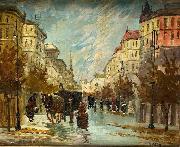 |
Berkes Antal
|
|
(1874-1938) was a Hungarian painter, born in Budapest, Hungary. Lived in Paris for some time and produced cityscapes there as well as similar street scenes of Budapest and Vienna.
He studied at The Academy of Fine Arts between 1889-1894 in Budapest, Hungary. He first started painting landscapes, and later changed to painting street scenes of Budapest. His popularity and sales increased so he started "mass producing" many of his works, meeting the requirements of the art dealers of his age. His work went through light and dark periods as he experimented with light.
|
|
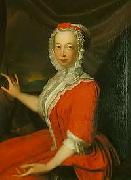 |
Bernardus Accama
|
|
(1697, Burum? - 1756, Leeuwarden) was an eighteenth century Dutch historical and portrait painter, born in Friesland. Active in Leeuwarden.
|
|
 |
BERRUGUETE, Alonso
|
|
Spanish Mannerist Painter and Sculptor, ca.1488-1561
Alonso Berruguete was born in Paredes de Navas, Valladolid, the son of Pedro Berruguete, Spain's first major Early Renaissance painter. Pedro was trained in Italy, and it is understandable that he would want his son to have an Italian formation. Alonso was in Florence from about 1504, the year of his father's death, until about 1517. He also spent time in Rome during this period.
Berruguete's original purpose was to train as a painter, but he had the opportunity to study sculpture under Michelangelo, whom he is said to have assisted in the execution of some works. Berruguete received minor commissions, such as the completion of paintings and sculptures left unfinished by other artists.
On his return to Spain, Berruguete executed an alabaster relief, the Resurrection, for Valencia Cathedral (ca. 1517), which compares favorably with early works by Michelangelo. It is Hellenistic in its anatomical beauty, multiple diagonals, and range of relief projection. The figure of Christ is the climactic center of interest: a vertical, stabilizing force amid a tumult of diagonals described in the agitated movements of the startled Roman soldiers.
In 1518 Emperor Charles V named Berruguete court painter. When illness prevented Berruguete from sailing to Germany with Charles V in 1520, the Emperor took it personally and turned a deaf ear to Berruguete's subsequent petitions for commissions. He then returned to his native village until 1523, when Charles V named him a scribe of the criminal section of the Chancery in Valladolid.
This gave Berruguete social status, an income, and work he could deputize. Henceforth, he set himself to amass riches and advance socially. He established a studio in Valladolid, hired a number of apprentices, and priced his works above those of all other artists. It was a time of great wealth in Spain; Berruguete had seen sumptuous riches in Italy and was determined to so live that his compatriots would accord him the reverence and acclaim enjoyed by Italian artists.
In 1528 Berruguete built himself a palace in Valladolid, opposite the monastery of S. Benito, for which he created his greatest altarpiece. He succeeded so well in his ambitions that in 1542 he sold the Emperor's benefice for 4,000 ducats. Two years before he died, he became a squire when the regent of Portugal, Princess Juana, gave him the village of Ventosa with its 120 inhabitants. |
|
|
|
|
|
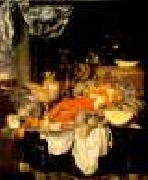 |
BEYEREN, Abraham van
|
|
Dutch Baroque Era Painter, ca.1620-1690
Dutch painter. He painted seascapes as well as fruit, flower, fish, game and banquet still-lifes. He almost always signed these works with his monogram AVB, but he dated only a few. This, together with the fact that he painted diverse subjects simultaneously and his style changed little, makes it difficult to establish a chronology. He became a master in The Hague in 1640 and was related by marriage to the fish painter Pieter de Putter (before 1600-59). Van Beyeren lived in Delft from 1657 to 1661 and was again in The Hague between 1663 and 1669. |
|
 |
Bierstadt Albert
|
|
German-born American Hudson River School Painter, 1830-1902
was a German-American painter best known for his large landscapes of the American West. In obtaining the subject matter for these works, Bierstadt joined several journeys of the Westward Expansion. Though not the first artist to record these sites, Bierstadt was the foremost painter of these scenes for the remainder of the 19th century. Bierstadt was part of the Hudson River School, not an institution but rather an informal group of like-minded painters. The Hudson River School style involved carefully detailed paintings with romantic, almost glowing lighting, sometimes called luminism. Bierstadt was born in Solingen, Germany. His family moved to New Bedford, Massachusetts, in 1833. He studied painting with the members of the D??sseldorf School in D'sseldorf, Germany from 1853 to 1857. He taught drawing and painting briefly before devoting himself to painting. Bierstadt began making paintings in New England and upstate New York. In 1859, he traveled westward in the company of a Land Surveyor for the U.S. government, returning with sketches that would result in numerous finished paintings. In 1863 he returned west again, in the company of the author Fitz Hugh Ludlow, whose wife he would later marry. He continued to visit the American West throughout his career. Though his paintings sold for princely sums, Bierstadt was not held in particularly high esteem by critics of his day. |
|
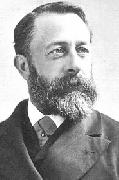 |
Bierstadt, Albert
|
|
The landscape painter
Bierstadt joined a surveying expedition to the western United States in 1858 after studying painting in Germany. |
|
 |
BLOEMAERT, Abraham
|
|
Dutch Mannerist Painter, ca.1564-1651
Abraham Bloemaert (1566, Gorinchem - January 27, 1651, Utrecht), was a Dutch painter and printmaker in etching and engraving.
Bloemaert was the son of an architect, who moved his family to Utrecht in 1575, where Abraham was first a pupil of Gerrit Splinter (pupil of Frans Floris) and of Joos de Beer. He then spent three years in Paris, studying under several masters, and on his return to his native country received further training from Hieronymus Francken. In 1591 he went to Amsterdam, and four years later settled finally at Utrecht, where he became dean of the Guild of St. Luke.
He excelled more as a colourist than as a draughtsman, was extremely productive, and painted and etched historical and allegorical pictures, landscapes, still-life, animal pictures and flower pieces. Among his pupils are his four sons, Hendrick, Frederick, Cornelis and Adriaan (all of whom achieved considerable reputation as painters or engravers), the two Honthorsts, Ferdinand Bol and Jacob Gerritsz Cuyp. |
|
|
|
|
|
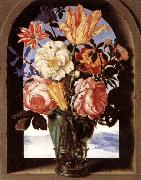 |
BOSSCHAERT, Ambrosius the Elder
|
|
Dutch Baroque Era Painter, 1573-1621
Painter and dealer. He left Antwerp with his parents c. 1587 because as Protestants they were vulnerable to religious persecution; the family moved to Middelburg, where in 1593 Ambrosius became a member of the Guild of St Luke, of which he served as Dean on several occasions (1597, 1598, 1603, 1604, 1612 and 1613). In 1604 he married Maria van der Ast, the sister of Balthasar van der Ast who later became his pupil and possible collaborator. Bosschaert bought a house in Middelburg in 1611. There are flower-pieces by Bosschaert that are signed (with a monogram) and dated between 1605 and 1621, though there were two periods of artistic inactivity, in 1611-13 and 1615-16, when he was probably more active as a dealer in the art of both Dutch and foreign artists (e.g. Veronese and Georg Flegel). He was recorded in Bergen-op-Zoom in 1615 and became a citizen of Utrecht in 1616, where his name appears in the register of the Utrecht Guild of St Luke for the same year. In 1619 he was involved in a court case in Breda, where he lived from that year. He died during a journey to The Hague. |
|
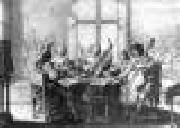 |
BOSSE, Abraham
|
|
French Baroque Era Engraver, 1602-1676
Roughly 1600 etchings are attributed to him, with subjects including: daily life , religion, literature , history, fashion[8], technology, and science. Most of his output was illustrations for books, but many were also sold separately. His style grows from Dutch and Flemish art, but is given a strongly French flavour. Many of his images give fascinating and informative detail about middle and upper-class daily life in the period, although they must be treated with care as historical evidence. His combination of very carefully depicted grand interiors with relatively trivial domestic subjects was original and highly influential on French art, and also abroad ?? William Hogarth's engravings are, among other things, a parody of the style. Most of his images are perhaps best regarded as illustrations rather than art.
Watercolour of a ball by Abraham Bosse, a similar subject to many of his most famous etchingsHe was apprenticed in Paris about 1620 to the Antwerp-born engraver Melchior Tavernier (1564?C1641), who was also an important publisher. His first etchings date to 1622, and are influenced by Jacques Bellange. Following a meeting in Paris about 1630, he became a follower of Jacques Callot, whose technical innovations in etching he popularised in a famous and much translated Manual of Etching(1645), the first to be published. He took Callot's highly detailed small images to a larger size, and a wider range of subject matter.
Unlike Callot, his declared aim, in which he largely succeeded, was to make etchings look like engravings, to which end he sacrificed willingly the freedom of the etched line, whilst certainly exploiting to the full the speed of the technique. Like most etchers, he frequently used engraving on a plate in addition to etching, but produced no pure engravings. |
|
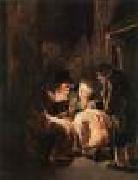 |
BOTH, Andries
|
|
Dutch Baroque Era Painter, ca.1612-1641
Andries Both (1612/1613, Utrecht - March 23, 1642, Venice) Dutch genre painter, one of the bamboccianti, and brother of Jan Dirksz Both.
Both was the son of a glass painter, and studied under Abraham Bloemaert. According to Joachim von Sandrart, Andries and his brother Jan cooperated on the paintings, with Jan painting the landscapes and Andries the figures, though this view has been revised in the 20th century. Andries stayed in Rouen in 1633, and he traveled on to Rome, where is documented from 1635 to 1641. He first shared a studio with a fellow painter from Utrecht, Jan van Causteren. In 1638 his brother joined him, living on the Via Vittoria in the parish of San Lorenzo in Lucina and perhaps both joining the Accademia di San Luca and the group of painters led by Pieter van Laer. In 1641 the brothers traveled back to Holland, but Andries met his death in Venice on the way, drowning in a canal as he was returning from some festivities. |
|
|
|
|
|
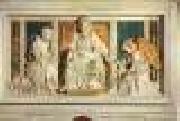 |
BREGNO, Andrea
|
|
Italian Early Renaissance Sculptor and Architect, 1418-1503
Andrea Bregno was invited to move from Venice to Rome when the Venetian Paul II was elected Pope. During the pontificate of the Della Rovere Pope Sixtus IV he received many commissions and headed a large workshop, producing many wall tombs of cardinals and other figures of the papal curia with varying degrees of personal responsibility. He was famous among his contemporaries, and was compared to the Greek sculptor Polykleitos in the epitaph of his tomb in Santa Maria sopra Minerva. Raphael's father, Giovanni Santi, mentioned Bregno in the 1480s, in his biography of Federico da Montefeltro, duke of Urbino. Bregno often worked with Mino da Fiesole in Rome, and his refined Lombard manner was rendered more classical by the contact and by the example of Roman sculptures that were increasingly coming to light, of which Andrea Bregno was an early collector: a certain "Prospettivo Milanese", writing in 1499-1500 refers to a torso in the collection of a "Maestro Andrea" that seems to have been the Belvedere Torso.
He moved in humanist circles and was an esteemed friend of the humanist in Sixtus' circle, Bartolomeo Platina, the librarian of the Vatican Library. Bregno played a significant role in the standardization of an authentically classicizing style of epigraphy, in the inscriptions that accompany his tombs. In the Sistine Chapel he collaborated with Mino da Fiesole and Giovanni Dalmata to produce the little cantoria or choristers' gallery set into the wall, with its own coffered ceiling and carved marble balusters, and the marble screen. |
|
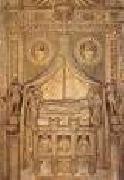 |
BREGNO, Antonio
|
|
Italian Early Renaissance Sculptor and Architect, active ca.1425-1457 |
|
|
|
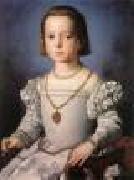 |
BRONZINO, Agnolo
|
|
Italian Mannerist Painter, 1503-1572
Italian painter and poet. He dominated Florentine painting from the 1530s to the 1560s. He was court artist to Cosimo I de' Medici, and his sophisticated style and extraordinary technical ability were ideally suited to the needs and ideals of his ducal patron. He was a leading decorator, and his religious subjects and mythological scenes epitomize the grace of the high maniera style. |
|
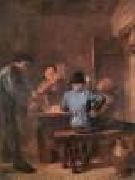 |
BROUWER, Adriaen
|
|
Flemish Baroque Era Painter, ca.1605-1638
Adriaen Brouwer (1605, Oudenaarde - January 1638, Antwerp) was a Flemish genre painter active in Flanders and the Dutch Republic in the seventeenth century.
At a young age Brouwer, probably born as Adriaen de Brauwer, moved perhaps via Antwerp to Haarlem, where he became a student of Frans Hals alongside Adriaen van Ostade. He also was active in stage acting and poetry. He stayed in Haarlem and Amsterdam until 1631, when he moved back to Antwerp in the Spanish Netherlands. There, he became a member of the Guild of St. Luke in 1631 ?C 1632, as well as the rhetoricians's chamber De Violieren.
Tradition has it that Brouwer himself spent much time in the alehouses of Flanders and Holland. His works are typically detailed and small, and often adopt themes of debauchery, drunkenness and foolishness in order to explore human emotions, expressions and responses to pain, fear and the senses. The Bitter Tonic (illustrated right) is an example of the type of work that depicts such responses, in this case the sense of taste. His work was well liked, to the point that forgeries were sold in his own time. Both Rubens and Rembrandt owned a number of his works. Nevertheless, Brouwer appeared in financial trouble throughout his life.
He died at the early age of 32 in Antwerp, where he was first buried in a common grave, but, upon instigation of the members of the guild, was reburied on Feb 1, 1638 in the church of the Carmelites. |
|
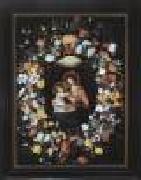 |
BRUEGHEL, Ambrosius
|
|
Flemish painter (b. 1617, Antwerpen, d. 1675, Antwerpen).
Ambrosius Brueghel (Antwerp, 1617??9 February 1675) was a Flemish Baroque painter who specialized in landscapes and flower paintings. His work is similar to that of his half-brother, Jan Brueghel the Younger, and his nephew, Abraham Brueghel.[1] He was primarily active Antwerp, probably travelled to Italy around 1639, and was dean of Antwerp's Guild of St. Luke from 1653 to 1671. |
|
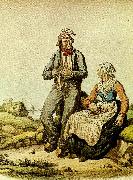 |
c. a. dahlstrom
|
|
Carl Petter Dahlström, född ca 1705, död 4 mars 1794, var en svensk möbelsnickare. Dahlström gesällvandrade 1745?C1755 i Nordeuropa och Frankrike, där han i Paris kom i lära hos den tidens främste ebenist Jean-François Oeben. Hos denne lärde sig Dahlström faneringstekniken marqueterie ?? fleurs eller blomsterintarsia, som var en metod för att möta rokokons krav på fanering av dubbelvälvda kroppar. Mycket tack vare rekommendationer av C.J. Cronstedt blev Dahlström efter hemkomsten till Sverige utnämnd till kunglig ebenist den 19 november 1756. Han finns representerad på Nationalmuseum med en byrå som han tillverkade tillsammans med Lorentz Nordin. Dahlström överlämnade 1769 sina privilegier till Niclas Palmgren och ägnade sig därefter åt restaurangverksamhet. |
|
|
|
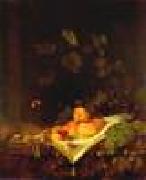 |
CALRAET, Abraham van
|
|
Dutch painter, Dordrecht school (b. 1642, Dordrecht, d. 1722, Dordrecht)
Dutch painter. He was the eldest son of Pieter Jansz. van Calraet (c. 1620-81), a sculptor from Utrecht. According to Houbraken, Abraham was taught by the Dordrecht sculptors Aemilius and Samuel Huppe, although nothing is known of his activity as a sculptor. Houbraken also stated that Abraham learnt to paint figures and fruit and that his brother Barent van Calraet (1649-1737), who specialized at first in horse paintings but later imitated the Rhine landscapes of Herman Saftleven, was a pupil of Aelbert Cuyp (see CUYP, (3)). The known signed works by Barent confirm this. A painting of two horses in a stable, initialled APK (Rotterdam, Mus. Boymans-van Beuningen), indicates that Abraham, too, must have been well acquainted with Cuyp and provides the basis for identifying Abraham's painting style. A large number of landscapes with horses, paintings of livestock in stables and still-lifes, all initialled A.C. and formerly attributed to Aelbert Cuyp, |
|
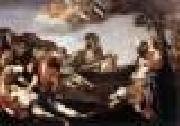 |
CAMASSEI, Andrea
|
|
Italian painter, Roman school (b. 1602, Bevagna, d. 1649, Roma)
Andrea Camassei (1602-1649) was an Italian painter of the Baroque, who was mainly active in Rome under the patronage of the Barberini. He was born in Bevagna. He was active in painting in the Palazzo Barberini as well as in Antonio Barberini's favored church, Santa Maria della Concezione, where he painted the Assumption of the Virgin on the dome. His training was under Domenichino, but he also labored under the direction of Sacchi and Pietro da Cortona. He painted a Triumph of Constantine for the Baptistery of the Lateran Palace. He painted for the Taddeo Barberini, two large canvases (1638-39) depicting Massacre of the Niobids and Hunt of Diana. He also painted a Saints Bonaventura, Bernardino & Ludovico da Tolosa for Santa Caterina in Rapecchiano (Spello). |
|
 |
Cano, Alonso
|
|
Spanish, 1601-67
Spanish painter, sculptor and architect. He was an artist of rare versatility in 17th-century Spain, although his architectural work was not extensive. While he is also known for his drawings, only about 60 of these are definitely attributable to him, despite the many extant sketches with the name 'Cano' carelessly added by later hands. Unlike most of his Spanish contemporaries, such as Zurbaren or Velezquez, whose artistic styles did not outlive them, Cano's artistic legacy is measured in part by the number of artists who trained in his workshop and went on to become important masters in their own right: the painters Pedro Atanasio Bocanegra, Juan de Sevilla (1643-95) and, more distantly, Jos Risueo, and the sculptors Pedro de Mena and Jos de Mora, |
|
|
|
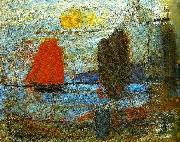 |
carl kylberg
|
|
Carl Oscar Kylberg, född 23 september 1878 på Vasängen i Fridene församling, död 6 januari 1952 i Stockholm, svensk konstnär och representant för Göteborgskoloristerna.
Carl Kylberg var son till kontorschef Gustaf Kylberg och friherrinnan Eleonora von Essen och storebror till konstnären Erik Kylberg. Hans fastrar och farbror var konstnärerna Regina Kylberg-Bobeck, Marina Kylberg och Hjalmar Kylberg. Farfadern Lars Wilhelm Kylberg var konstnär vid sidan av lantbruket på familjegodset Såtenäs i Västergötland.
Kylberg studerade först vid tekniska skolan i Stockholm och i Berlin för att bli arkitekt men övergick till måleri omkring 1900. Han studerade under en tid vid Valand i Göteborg som elev till Carl Wilhelmson. Hans verk kännetecknas ofta av ett glödande oljemåleri med starka färger och han avbildade ofta landskap och figurkompositioner på ett avskalat man??r. Under senare delen av sitt konstnärskap skapade han en mängd religiösa motiv.
Kring 1930-talet fick han sitt genombrott och han kom att ställa ut, förutom i Sverige även i Köpenhamn, Paris, London, Budapest och i USA men hans måleri var för många provocerande och 1938 gick regeringen in och stoppade ett köp av målningen Uppbrottet för Nationalmuseum i Stockholm.
En av hans mest välkända målningar är Hemkomsten från 1938 som hänger på Göteborgs konstmuseum och som föreställer ett skepp i silhuett mot en nästan brinnande gul himmel och ett rödfärgat hav. Denna målning förevigades också 1978 på ett svenskt frimärke av valören 90 öre.
Sedan 1980-talet har många av hans tavlor sålts för rekordpriser vid olika internationella konstauktioner.
|
|
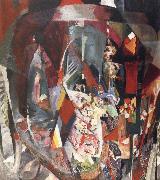 |
Carles Arthur Beecher
|
|
American Modernist Painter, 1882-1952
was an American Modernist painter. He was born in Philadelphia, Pennsylvania, and studied at the Pennsylvania Academy of the Fine Arts between 1900 and 1907. He studied with Thomas Pollock Anshutz, Hugh Breckenridge, Henry McCarter, Cecilia Beaux, and William Merritt Chase. In 1907 he traveled to France where he remained until 1910. In France, he greatly admired the works of Cezanne and Matisse, and became close friends with John Marin and Eduard Steichen. He displayed six landscapes in the Salon d'Automne of 1908. |
|
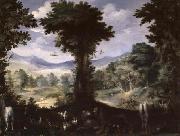 |
Carlo Antonio Procaccini
|
|
(born 1555) was an Italian painter of the late-Renaissance period.
He was the third son of Ercole, the brother of Camillo and Giulio Cesare the elder, and father of Ercole Procaccini the Younger (1605?C1675). He was born at Bologna and initially trained by his father, though he excelled in painting landscapes and still-lifes with flowers and fruit, mainly in Milan.
|
|
|
|
 |
Carnicero, Antonio
|
|
Spanish, approx. 1748-1814
Painter and draughtsman, son of Alejandro Carnicero. He arrived at the Court in Madrid with his father in 1749 and took part in the competitions held by the Real Academia de S Fernando, winning second prize in 1769 with the Coronation of Alfonso XI and Queen Mary in the Monastery of Huelgas de Burgos (Madrid, Real Acad. S Fernando, Mus.). In 1760 he won a scholarship to Rome, subsequently winning prizes from the Accademia di S Luca. On his return to Madrid in 1766 he worked as a portrait painter, producing works such as the portrait of Do?a Tomasa de Aliaga, Widow of Salcedo (Madrid, Prado). In 1788 he was elected an honorary member of S Fernando. Under the protection of the Spanish prime minister, Manuel Godoy, Prencipe de la Paz, whom he painted on several occasions , and after painting the portraits of Charles IV and Maria Luisa (both Madrid, Monasterio de la Encarnacien), he was appointed Pintor de Cemara in 1796. In 1798 he applied unsuccessfully for the post of drawing-master to the Prince of Asturias, the future Ferdinand VII, although by 1806 he was teacher of the Infante Princes. He was a refined draughtsman and prepared illustrations for the editions of Cervantes's El ingenioso hidalgo Don Quixote de la Mancha published by the Real Academia Espa?ola (Madrid, 1780; 1782). He also made the drawings for the handsome engravings (Madrid, Calcografra N.) of the Real Picadero (Royal Riding School). In addition to his portraiture, which displays a talent for realism and wit, although at times combined with slightly garish colours, Carnicero executed attractive and descriptive costumbrista paintings, depicting everyday life, popular gatherings and hunting scenes, for instance Duck Shooting on the Albufera, Valencia |
|
|
|
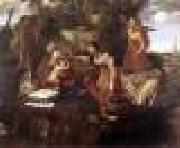 |
CAROSELLI, Angelo
|
|
Italian painter, Roman school (b. 1585, Roma, d. 1652, Roma)
Italian painter. He was the son of a dealer in second-hand goods and taught himself to paint. According to Baldinucci, he knew Caravaggio, who fled Rome in 1606, and this association may have encouraged his decision to become a painter. After visits to Florence (1605) and Naples (1613), Caroselli settled in Rome, where, in 1615, he married a Sicilian, Maria Zurca. His weakness for beautiful women was notorious (Baldinucci; Passeri). His second marriage, to Brigitta Lauri, daughter of the Flemish painter Balthasar Lauwers or Lauri (1578-1645), |
|
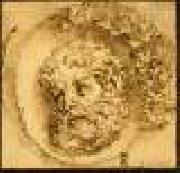 |
CARRACCI, Agostino
|
|
Italian Baroque Era Painter, 1557-1602
Painter, engraver and draughtsman, cousin of Ludovico Carracci. He abandoned his profession as a tailor, which was also that of his father, Antonio, and began training as a painter. According to Faberi, he studied first in the workshop of the painter Prospero Fontana (like Ludovico), then trained under the engraver and architect Domenico Tibaldi and under the sculptor Alessandro Menganti (1531-c. 1594). However, it is likely that Faberi's account was influenced by his desire to present Agostino's career as an example of the versatile 'cursus studiorum' advocated by the Accademia degli Incamminati. Other sources (Mancini, Malvasia, Bellori) agree that it was his cousin Ludovico who was responsible for directing him towards painting. |
|
 |
CARRACCI, Annibale
|
|
Italian Baroque Era Painter, 1560-1609
Painter, draughtsman and printmaker, brother of Agostino Carracci. Since his lifetime, he has been considered one of the greatest Italian painters of his age. His masterpiece, the ceiling (1597-1601) of the Galleria Farnese, Rome, merges a vibrant naturalism with the formal language of classicism in a grand and monumental style. |
|
 |
CARRACCI, Antonio
|
|
Italian Baroque Era Painter, ca.1583-1618
Painter, son of Agostino Carracci. He was born either c. 1583 (Baglione) or in 1589 (Bellori). His mother was a Venetian courtesan named Isabella. After his father's death, he joined the Roman household of his uncle Annibale Carracci. While Antonio may have collaborated with other studio assistants on the wall frescoes (1603-4) of the Galleria Farnese and the decoration (1606; commissioned from Francesco Albani) of some rooms in the Palazzo Mattei di Giove, Rome, his earliest undisputed works date from after Annibale's death in 1609. At that time, according to Monsignor G. B. Agucchi (Malvasia), Antonio returned briefly to Bologna, with the intention of joining Ludovico Carracci's studio, but the proposed collaboration came to nothing. A frescoed Vision of St Francis in the lower oratory of S Colombano was most probably painted during this Bolognese sojourn, and his Burial of Christ (Rome, Gal. Borghese) dates from c. 1609. He returned to Rome in 1610 and assisted Guido Reni in the Pauline Chapel of the Palazzo del Quirinale, where he painted Virtues and other subsidiary figures on the walls. |
|
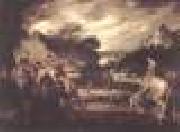 |
CASTILLO, Antonio del
|
|
b. 1616, Cordoba, d. 1668, Cordoba
Spanish painter and draughtsman. He studied first with his father, Agust?n del Castillo (d July 1631), a painter also known for his drawings, and in November 1631 began a three-year apprenticeship with Ignacio de Aedo Calderen, a painter of religious figures ( pintor de imaginera). From 1635 to 1638 Castillo was also known as painter and pintor de imaginera, and by December 1638 |
|
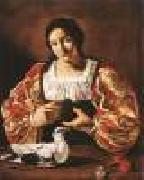 |
CECCO DEL CARAVAGGIO
|
|
Italian Baroque Era Painter, active ca.1610-1620
Painter active in Italy. His nationality is not known. He was a follower of Caravaggio, and his rare works reveal a highly original and idiosyncratic response to that artist's naturalism. Agostino Tassi mentioned him as involved, with several French artists, in the decoration of the Villa Lante at Bagnaia between 1613 and 1615, |
|
 |
CELESTI, Andrea
|
|
Italian painter, Venetian school b. 1637, Venezia, d. 1712, Venezia,Italian painter. He trained first with Matteo Ponzoni, then with Sebastiano Mazzoni; Mazzoni encouraged the development of a Baroque style, but Celesti was also attracted by the naturalism of the tenebrists. The first known works by Celesti are mature in style, and he had already achieved considerable fame in Venice when the Doge Alvise Contarini honoured him with the title of Cavaliere in 1681. The complexity of his sources is evident in two canvases, Moses Destroying the Golden Calf and Moses Chastising the Hebrew People for their Idolatry, both painted c. 1681 for the Palazzo Ducale, Venice, and signed Cavaliere; they are influenced by Luca Giordano and by the narrative techniques of Jacopo Tintoretto. The most distinguished works of Celesti's early period are two large lunettes that show three scenes: Benedict III Visiting St Zacharias, A Doge Presented with the Body of a Saint, and the Virtues Surrounding a Doge Holding the Model of St Zacharias (c. 1684; Venice, S Zaccaria). These luxuriant compositions represent a remarkable leap in quality from the paintings of the Palazzo Ducale, with lighter colours and a more flickering touch. A little later Celesti left Venice for Brescia, perhaps by way of Rovigo; exactly when he arrived is not known, but he established himself and his studio there for several years. Panfilo Nuvolone and Francesco Paglia (1636-1713) had encouraged the development of a more exuberant Baroque style in Brescia, and in response Celesti created more decorative, lyrical works, such as his ecstatic St Rose of Lima (Brescia, S Clemente) with its brilliant display of glorious light. Most of Celesti's paintings done in and around Brescia were religious canvases, but he also painted portraits, such as the two entitled Condottiero (Ljubljana, Slov. Acad. Sci. & A.) and the portrait of Conte Alberto di Baone (Dublin, N.G.), executed in a dazzling array of colours. In 1688 Celesti was active at Toscolano on Lake Garda, where he painted canvases of scenes from the Life of St Peter (Toscolano Cathedral) and in 1689 decorated the salone of the Palazzo Delay (now Palazzo Mafizzoli) with Old Testament scenes. In 1696 he was at Treviso, where he executed a Last Judgement for the cathedral (untraced) and in 1697, 1698 and 1699 pictures for the abbey of S Floriano at Linz, where his Paradise, for the high altar, remains in situ. By 1700 Celesti was back in Venice, where he set up his studio; Venetian artists of this period, led by Giovanni Coli and Filippo Gherardi, were reviving the style of Veronese, and Celesti, following this trend, produced late works that employed more dazzling effects of colour and light. These works include the frescoed decoration of the Villa Rinaldi Barbini at Casella d'Asolo, where Celesti created a series of exotic and theatrical mythological and biblical scenes, distinguished by their luminosity and by their light and airy touch. His last works were three dramatic night scenes: the Birth of the Virgin, the Assumption of the Virgin and the Martyrdom of St Lawrence (1706-11; Verolanuova Cathedral). Celesti was much admired by Charles-Nicholas Cochin (i) and by Jean-Honor? Fragonard, and his colour influenced the Rococo art of the early 18th century in Venice and in Austria. |
|
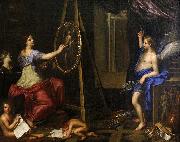 |
Charles Alphonse du Fresnoy
|
|
(1611C1665), French painter and writer on his art, was born in Paris, son of an apothecary.
He was destined for the medical profession, and well educated in Latin and Greek; but, having a natural propensity for the fine arts, he would not apply to his intended vocation, and was allowed to learn the rudiments of design under Perrier and Vouet. At the age of twenty-one he went off to Rome, with no resources; he drew ruins and architectural subjects.
After two years thus spent he re-encountered his old fellow-student Pierre Mignard, and by his aid obtained some amelioration of his professional prospects. He studied Raphael and the antique, went in 1633 to Venice, and in 1656 returned to France. During two years he was now employed in painting altar-pieces in the château du Raincy, landscapes, etc. His death was caused by an attack of apoplexy followed by palsy; he expired at Villiers-le-Bel, near Paris. He never married.
His pictorial works are few; they are correct in drawing, with something of the Caracci in design, and of Titian in colouring, but wanting fire and expression, and insufficient to keep his name in any eminent repute.
He is remembered now almost entirely as a writer rather than painter. His Latin poem, De arte graphica, was written during his Italian sojourn, and embodied his observations on the art of painting; it may be termed a critical treatise on the practice of the art, with general advice to students. The precepts are sound according to the standard of his time; the poetical merits slender enough. The Latin style is formed chiefly on Lucretius and Horace. |
|
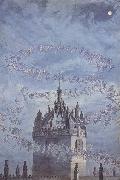 |
Charles Altamont Doyle
|
|
1832-1893
was a Victorian artist. He was the brother of the artist Richard Doyle, and the son of the artist John Doyle. Although the family was Irish, Doyle was born and raised in England. In 1849 he moved to Edinburgh where he met Mary Foley. They were married on 31 July 1855. Their children included Arthur Conan Doyle, creator of Sherlock Holmes, John Francis Innes Hay Doyle (known as Innes or Duff), and Jane Adelaide Rose Foley n??e Doyle (known as Ida). Doyle was not as successful an artist as he wished, and suffered depression and alcoholism. His paintings, which were generally of fairies, such as "A Dance Around The Moon", or similar fantasy scenes, reflected this, becoming more macabre over time. In 1881 Doyle was committed to a nursing home specialising in alcoholism. While there, his depression grew worse, and he began suffering epileptic seizures. Following a violent escape attempt he was sent to Sunnyside, Montrose Royal Lunatic Asylum, where he continued to paint. He died in Crighton Royal Institution in 1893. |
|
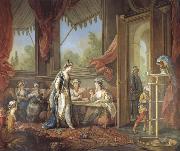 |
Charles Amedee Philippe Van Loo
|
|
French Painter, 1719-1795, was a French painter of allegorical scenes and portraits. He studied under his father, the painter Jean-Baptiste van Loo, at Turin and Rome, where in 1738 he won the Prix de Rome, then at Aix-en-Provence, before returning to Paris in 1745. He was invited to join the Academie Royale de Peinture et de Sculpture in 1747, and that year he married his cousin Marie-Marguerite Lebrun, daughter of the painter Michel Lebrun (died 1753). Among his brothers were the painters Francois van Loo (1708-1732) and Louis-Michel van Loo (1707-1771). |
|
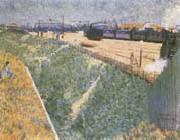 |
Charles Angrand
|
|
French Pointillist Painter, 1854-1926.French painter. He was trained at the Acad?mie de Peinture et de Dessin in Rouen, where he won prizes. Although he failed to gain entry to the Ecole des Beaux-Arts in Paris, Angrand began to win a controversial local reputation for canvases in a loosely Impressionist manner. In 1882 he secured a post as a schoolteacher at the Coll?ge Chaptal in Paris. With this security he was able to make contacts in progressive artistic circles, and in 1884 he became a founder-member of the Salon des Ind?pendants. His paintings of this period depict rural interiors and kitchen gardens, combining the broken brushwork of Monet and Camille Pissarro with the tonal structure of Bastien-Lepage (e.g. In the Garden, 1884; priv. col., see 1979 exh. cat., p. 27). |
|
|
|
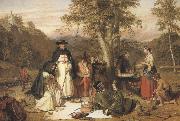 |
Charles landseer,R.A.
|
|
1799-1879
Painter, brother of Thomas Landseer. He trained initially with his father John Landseer, then under Benjamin Robert Haydon, and in 1816 he attended the Royal Academy Schools in London. In 1823 he accompanied Sir Charles Stuart de Rothesay (1779-1845) aboard HMS Wellesley on a voyage to Portugal and then to Brazil, in order to negotiate a commercial treaty with Pedro I, Emperor of Brazil (reg 1822-31). Many of the drawings he made on this trip were exhibited in 1828 at the British Institution, and in that year he sent his first painting to the Royal Academy. This was Dorothea, illustrating a scene from Cervantes's Don Quixote. He continued to exhibit at the Academy until his death, showing mostly romanticized history paintings or such literary subjects as Clarissa Harlowe in the Sponging House from Samuel Richardson's novel Clarissa (London, 1748). The English Civil War (1642-51) was of particular interest to him, his devotion to such historical subjects perhaps being attributable to the influence of his years with Haydon. He also painted portraits, genre scenes and animal studies . In 1837 he was elected ARA and in 1845 RA. In 1851, probably due to the influence of his brother Edwin, he succeeded George Jones as Keeper of the Royal Academy Schools. Responsible for instructing the antique class, his tenure was criticized both for the way his position had been obtained and for the deficiency of his teaching, and he retired from the Keepership in 1873 on full salary. |
|
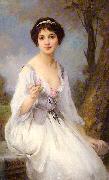 |
Charles-Amable Lenoir
|
|
(22 October 1860 - 1926) was a French painter. Like his mentor, William-Adolphe Bouguereau, he was an academic painter and painted realistic portraits as well as mythological and religious scenes. His artistic career was so prestigious that he won the Prix de Rome twice and was awarded the Legion d'honneur.
Lenoir was born in Châtellaillon, a small town just outside of La Rochelle. His mother was a seamstress and his father was a customs officer. When he was young, his father was reassigned and the family moved to Fouras. He did not start out in life as an artist, but instead began his education at a teachers' college in La Rochelle. Upon graduation, he worked as a teacher and supervisor at the lycee in Rochefort.
In August 1883 he was accepted into the École des Beaux-Arts de Paris, he also joined the Academie Julian where he was a student of William-Adolphe Bouguereau and Tony Robert-Fleury. Lenoir made his artistic debut at the Salon in 1887 and continued to exhibit there until his death. He was quickly noticed in the art world, and in 1889 won the Second Prix de Rome for his painting, Jesus et le paralytique (Jesus and a Sick Man with Palsy), and he won the First Prix de Rome the following year for Le Reniement de Saint Pierre (The Denial of St. Peter).His awards did not stop with the Prix de Rome; works shown at the Salons also won prizes, and he received a third-class medal in 1892 for Le Grenier a Vingt Ans (The Garret at twenty years) and a second-class medal in 1896 for La Mort de Sappho (The Death of Sappho). |
|
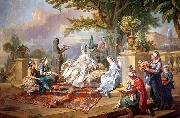 |
Charles-Amedee-Philippe van Loo
|
|
(25 August 1719 -15 November 1795) was a French painter of allegorical scenes and portraits.
He studied under his father, the painter Jean-Baptiste van Loo, at Turin and Rome, where in 1738 he won the Prix de Rome, then at Aix-en-Provence, before returning to Paris in 1745. He was invited to join the Academie Royale de Peinture et de Sculpture in 1747, and that year he married his cousin Marie-Marguerite Lebrun, daughter of the painter Michel Lebrun (died 1753).
Among his brothers were the painters François van Loo (1708-1732) and Louis-Michel van Loo (1707-1771).
|
|
|
|
|

